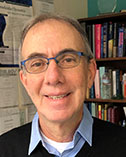
Kerry S. Bloom
The University of North Carolina at Chapel Hill
|
Primary Section: 26, Genetics Secondary Section: 22, Cellular and Developmental Biology Membership Type:
Member
(elected 2021)
|
Biosketch
Kerry Bloom is recognized for his work studying dynamic aspects of the cytoskeleton and chromosomes in live cells. He is known for work on the chromatin structure of active genes and most recently biophysical studies demonstrating the physical basis for how centromeric chromatin is built into a molecular spring that resists microtubule-based extensional forces in mitosis. Dr. Bloom was born in Washington D.C. He graduated from Tulane University (B.S. 1975) and received his Ph.D. in 1980 from Purdue University. He worked as a postdoctoral fellow with Dr. John Carbon at UC Santa Barbara and took his first and only job at the University of North Carolina at Chapel Hill in 1982. Bloom was an Instructor in the Physiology course at the MBL in Woods Hole MA for 10 years in the 80’s and 90’s, and an Instructor in the Science Writers course for 5 years in the early 2000’s. Bloom has a record of service in the American Society of Cell Biology where he is currently Secretary of the Society. He is a Lifetime Fellow of the ASCB, as well as a member of the American Academy of Arts and Sciences and the National Academy of Sciences.
Research Interests
Dr. Bloom has a long-standing interest in chromatin structure. He used nucleases to probe chromatin organization and studied the structure of active genes and centromeres. Dr. Bloom was an early developer of live cell microscopy and analysis of fluorescent protein fusions in budding yeast. He discovered a nuclear migration defect in dynein mutants that opened up the field for studying the mitotic exit checkpoint and genetic requirements for nuclear migration and spindle orientation in yeast and multicellular organisms. Turning back to the centromere, the visualization of centromere DNA dynamics challenged prevailing models of how cohesion holds sister centromeres together. Using bead-spring polymer models of chromosomes he discovered that the centromere is organized into a bottlebrush, in which the bulk of DNA is in radial loops, displaced from the primary axial core. The axial core is where tension is focused, and lies between kinetochore microtubules. They are currently using high spatiotemporal imaging of chromatin in vivo together with mathematical modeling to elucidate physical properties that underlie the formation and fluctuations of chromosomal territories, including the centromere and nucleolus. Introduction of tethers, cross-linkers and loop extrusion functionalities into the models sequester sub-domains and account for experimental observations.

